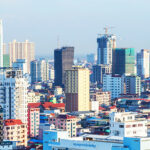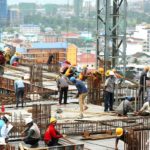
23 Aug Cambodia’s Investment Outlook for 2019
Located between Thailand and Vietnam, Cambodia is an attractive investment destination for businesses looking to expand in ASEAN. The country has recovered from a troubled and violent 20th century past and aims to now secure a place on the global economic playing field.
With a steady economic growth of around 7 percent in recent years, which is forecasted to continue in 2019, Cambodia is on a steady path of economic improvement. The growth rate is the highest amongst the fast-growing ASEAN nations. However large-scale reforms are needed to support this growth and to make the country competitive on a global level.
Economic Performance in 2018
In the second quarter of 2018, the FDI inflow increased for the fifth consecutive time in the last two years to US$ 832 million. Constant growth over the last decade has sustained the economy despite being somewhat overshadowed by the more advanced economies of neighboring Thailand and Vietnam.
In 2018, the garment industry and tourism sector primarily supported the economic performance of the country.
The tourism industry grew steadily with an 11 percent increase of international tourists coming to the country. The garment industry expanded in 2018 owing to relocation of companies to Cambodia due to rising wages in China and several factory incidents in Bangladesh. In the first half of 2018, garment exports increased by 11 percent.
Investment Climate
The Cambodian investment climate is driven by the country’s attractiveness for FDI. The country has very open investment laws and offers a range of incentives to investors. In combination with its close proximity to production facilities in Thailand and Vietnam as well as the Chinese market, the country represents a perfect investment opportunity.
The country’s Special Economic Zones (SEZ) offer a perfect setting for foreign investments especially in border areas and for the export-based manufacturing industry. Corporate tax exemption of up to eight years and further exemption on profits, if reinvested in the country, are among attractive incentives for investors. Complete duty and tax exemption on imports and exports for most industries are also available.
100 percent foreign ownership of companies is allowed in most sectors. The country’s investment law also provides regulations governing the protection of investments from regulated prices and nationalization. Yet the lack of Rule of Law and the high endemic corruption may partially weaken those provisions.
At the beginning of 2018, an agreement with the European Patent Organization came into force providing validation of EU patents in Cambodia. This allows with one single patent registration the coverage of the EU, Cambodia and other signatory states. With this agreement, EU companies can easily protect their innovations while producing in Cambodia for the Asian market.
Investment Climate
The Cambodian investment climate is driven by the country’s attractiveness for FDI. The country has very open investment laws and offers a range of incentives to investors. In combination with its close proximity to production facilities in Thailand and Vietnam as well as the Chinese market, the country represents a perfect investment opportunity.
The country’s Special Economic Zones (SEZ) offer a perfect setting for foreign investments especially in border areas and for the export-based manufacturing industry. Corporate tax exemption of up to eight years and further exemption on profits, if reinvested in the country, are among attractive incentives for investors. Complete duty and tax exemption on imports and exports for most industries are also available.
100 percent foreign ownership of companies is allowed in most sectors. The country’s investment law also provides regulations governing the protection of investments from regulated prices and nationalization. Yet the lack of Rule of Law and the high endemic corruption may partially weaken those provisions.
At the beginning of 2018, an agreement with the European Patent Organization came into force providing validation of EU patents in Cambodia. This allows with one single patent registration the coverage of the EU, Cambodia and other signatory states. With this agreement, EU companies can easily protect their innovations while producing in Cambodia for the Asian market.
This policy facilitates Cambodia with exclusive access to the EU common market without paying duties or tariffs. During the launched 18-month withdrawal period, human rights issues in Cambodia will be investigated by the EU. The EU represents the largest importer of Cambodian garment products with around 40 percent of all garment exports. Despite the impending setbacks of the EU market, the US market with a share of 30 percent and the rising Chinese demand can still back the local garment industry.
Further, the local energy supply represents a problem that needs to be tackled for further economic growth. Energy production depends on oil, coal and water power. However, these sectors are largely import depending or cause major environmental implications which leads to high energy prices in Cambodia. Backed by the national plan to connect all 24 provinces to the national grid by 2020, decentralized energy supply offers huge potential to solve the problem. Biogas, solar and wind power offer potential to spice up the energy mix and to quickly reduce the prices while making energy supply more reliable.
The Untapped Resources of Cambodia
Currently, the country is depending on imports of resources. Mainly oil, gas and coal are imported and not exploited in the country itself. Still, Cambodia offers a vast potential for self-exploitation of resources. Due to regional disputes with Thailand, the offshore oil resources have not been exploited so far. In 2018 the government started to facilitate exploration agreements for local oil resources.
Future opening up of the resources sector offer huge potential for investors. The infrastructure sector is in the need of investments as well. The local refinery production facilities are not able to handle large-scale exploitation operations. Reforms of the legal framework regarding the resource sector are in progress.
Cambodia’s Manufacturing Potential
Cambodia offers with its liberal investment law and the strategic location a perfect opportunity for manufacturing sites, also supplying the economies in accelerating Thailand and Vietnam. Current manufacturing companies focus on food and beverages, chemical rubber and plastic as well as paper processing.
The country’s SEZ’s can easily supply industries in Thailand and Vietnam as well as export to other countries. Especially regarding the US-China trade war, the country could position itself as a cheap alternative for manufacturing.
Agriculture – The Neglected Backbone of the Country
With around 40 percent of the workforce being employed in the agriculture sector, it remains in the heart of the Cambodian economy. The global demand for agricultural products – in particular from China that already represents 27 percent of the total exports in 2018 – is supporting the local production. Recent agreements for the promotion of organic food and the rising demand for such products in ASEAN can further facilitate development in the local food industry.
However, the local agricultural industry faces several problems. The sector is currently not competitive on a global level. Lack of infrastructure represents an obstacle, especially for the export-based agricultural industry.
Investing in Cambodia in 2019?
Cambodia offers several opportunities to get involved for investors. An open investment environment, cheap labor and the close location to the largest markets in the world support the investment incentives. EU patent protection and increasing reliability of the country’s infrastructure – especially in SEZ’s – make Cambodia interesting for manufacturing going beyond garment industry. Lowering production costs by self-exploitation of resources will support resource-based industries in the country in the near future as well.
Source: ASEAN Briefing





